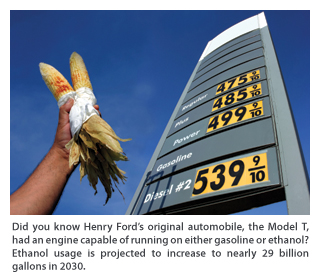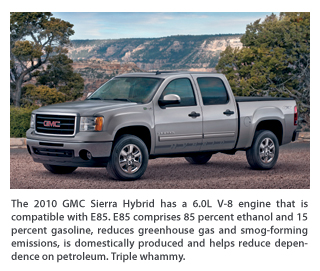Building Bio Power

With growing demand for alternative fuel choices, the biomass market is quickly maturing. Construction equipment and truck manufacturers are releasing news of biodiesel-ready machines, causing alternative fuel producers to pop up across the country. New sources of biofuel are being discovered at an incredible rate, and a distribution network is being built to meet the supply and demand. As the market becomes popular, professionals will need to understand their alternatives in the expanding fuel source industry.
 Biofuels are liquid fuels produced from biomass materials and are used primarily for transportation. The term biofuels most commonly refers to ethanol and biodiesel. In 2007, the United States consumed 6.7 billion gallons of ethanol and 358 million gallons of biodiesel. By comparison, 2007 consumption of motor gasoline and diesel (not inclusive of biofuels) was 136 billion gallons and 53 billion gallons, respectively.
Biofuels are liquid fuels produced from biomass materials and are used primarily for transportation. The term biofuels most commonly refers to ethanol and biodiesel. In 2007, the United States consumed 6.7 billion gallons of ethanol and 358 million gallons of biodiesel. By comparison, 2007 consumption of motor gasoline and diesel (not inclusive of biofuels) was 136 billion gallons and 53 billion gallons, respectively.
Biofuels are made by converting various forms of biomass such as corn or animal fat into liquid fuels and can be used as replacements or additives for gasoline or diesel. Biofuels generally have lower life-cycle carbon dioxide emissions than their fossil fuel counterparts. In recent years, several federal laws have been designed to increase the production and consumption of domestic biofuels.
The Energy Policy Act of 2005 established the Renewable Fuel Standard, which mandated that transportation fuels sold in the United States must contain a minimum volume of renewable fuels, the level of which increases yearly until 2022. In December 2007, the Energy Independence and Security Act of 2007 increased the mandatory levels of renewable fuel blending credits to a total of 36 billion gallons by 2022, including 16 million gallons of cellulosic biofuels.
What Is Ethanol?
Ethanol is a clear, colorless alcohol — the same as is found in alcoholic beverages. Ethanol is produced when yeast ferments sugar in a process similar to that used to produce beer. Ethanol can be made from the starches or sugars found in various agricultural crops, such as corn, barley and sugar cane or from cellulosic residues from woody biomass, such as bark or switchgrass. Cellulosic ethanol is considered an “advanced” biofuel and involves a more complicated production process than conventional ethanol made from starches or sugars. However, its commercial viability has yet to be demonstrated.
How Is Ethanol Used?
Prior to the passage of the Energy Policy Act of 2005, gasoline sold in certain geographic areas was required to contain oxygen, which helps the fuel mixture combust more completely. Originally, a chemical called methyl tertiary butyl ether (MTBE) was the preferred oxygenate, but it was phased out due to concerns about seepage into groundwater, and ethanol was mandated as a replacement. The usage of ethanol continued to gain market share due to the Renewable Fuel Standard requirements of the Energy Policy Act of 2005.
Today, a little more than half of the gasoline in the United States has some amount of ethanol blended into it. These blends are named by their ethanol content. For example, a blend of 90 percent gasoline and 10 percent ethanol (by volume) is known as E10. However, because ethanol contains approximately 67 percent the energy content of gasoline per gallon, usage of ethanol blends results in decreased gas mileage. Despite this fact, high crude oil prices and government incentives have resulted in the usage of increasing amounts of ethanol.

What Is Biodiesel?
Biodiesel consists of chemicals known as fatty acid methyl esters (FAME) that can be used as a diesel fuel substitute or diesel fuel additive. Biodiesel is typically made from oils produced from agricultural crops such as soybeans or canola but can also be made from various other feedstocks such as animal fats.
Currently, most biodiesel in the United States is produced from soybean oil, but recent increases in soybean crop prices have caused producers to switch to other feedstocks, such as waste animal fats from processing plants or recycled grease from restaurants. Biodiesel can be made from virtually any feedstock that contains an adequate amount of free fatty acids, which are the raw materials that are converted to biodiesel through a chemical process. Research is underway to harvest algae for biodiesel production because they contain fat pockets that help them float. This fat can be collected and processed into biodiesel.
In addition to biodiesel derived from FAME, it is also possible to make a diesel fuel substitute from cellulosic material. This fuel, sometimes called renewable diesel, would also count toward meeting the Renewable Fuel Standard mandate. Like cellulosic ethanol, its commercial viability has yet to be demonstrated.
How Is Biodiesel Used?
Biodiesel has chemical characteristics much like petroleum-based diesel and, therefore, can be used as a direct substitute for diesel fuel or blended with petroleum diesel in any percentage without suffering any significant loss of fuel economy. Blends are named in the same manner as ethanol-gasoline mixes. For example, a blend of 20 percent biodiesel with 80 percent petroleum diesel is known as B20. Low level (i.e., B2-B5) biodiesel blends are a popular fuel in the trucking industry because biodiesel has excellent lubricating properties, which can be beneficial for engine performance. Biodiesel also has virtually no sulfur content, making it a popular additive for low- and ultra-low-sulfur diesel fuels required by the Environmental Protection Agency.
How Much Do We Consume?
In 2007, the United States consumed 6.7 billion gallons of ethanol and 358 million gallons of biodiesel. According to EIA’s Annual Energy Outlook 2009, ethanol usage is projected to increase to nearly 29 billion gallons in 2030, which would represent approximately 20 percent of total gasoline consumption by volume. Consumption of renewable diesel, made from cellulosic materials, is expected to substantially exceed biodiesel consumption by this date as well.
For more information on biofuels, visit the Energy Information Administration, the Official Energy Statistics from the U.S. government at www.eia.doe.gov/bookshelf/brochures/diesel/index.html.

Comments are closed here.